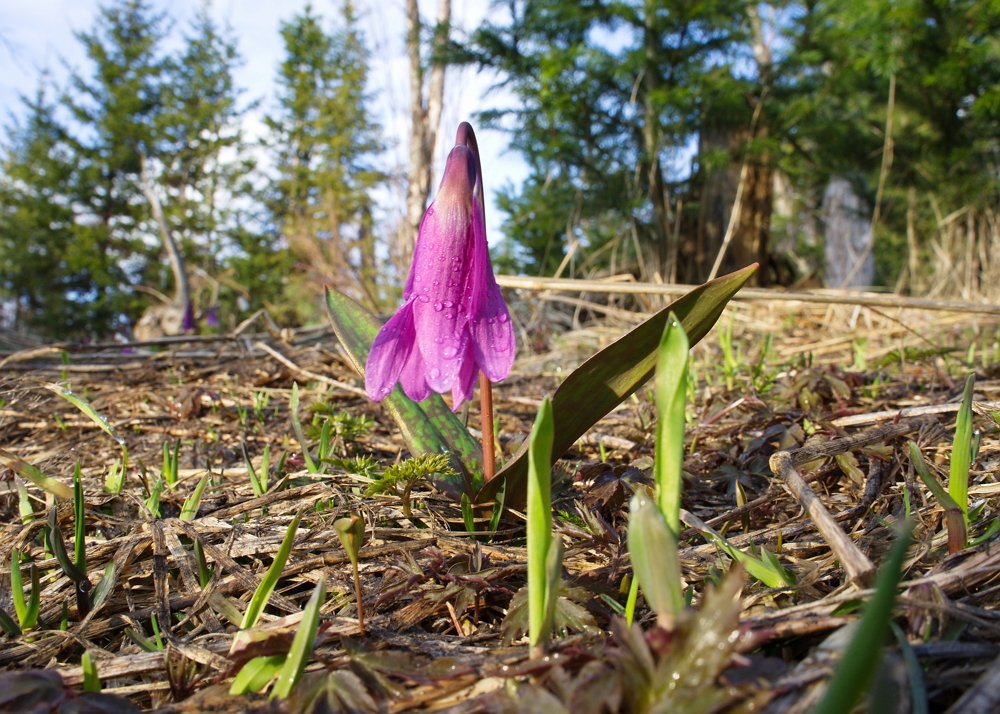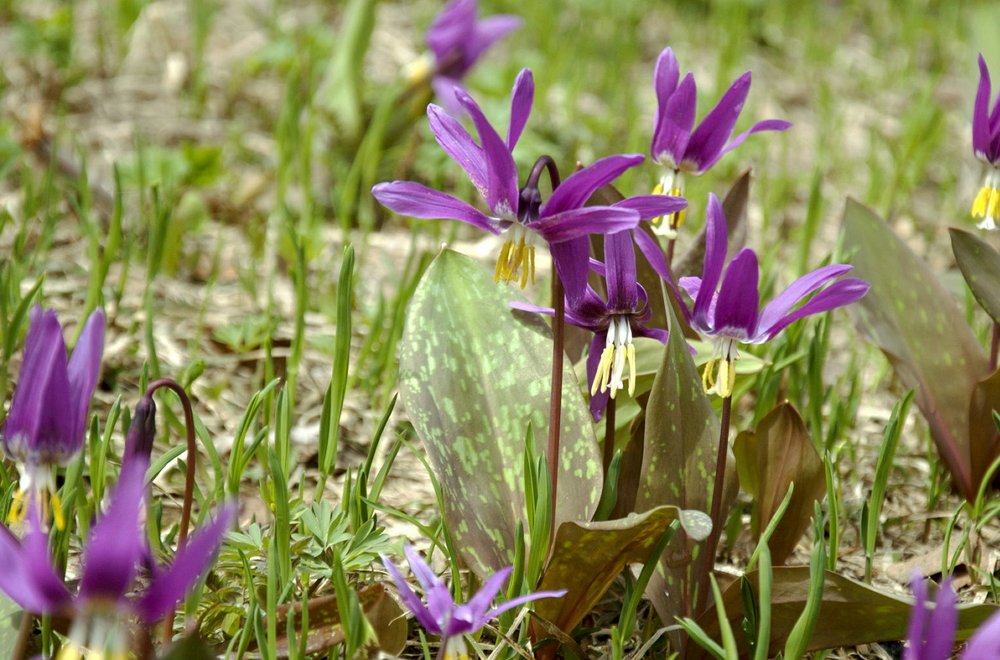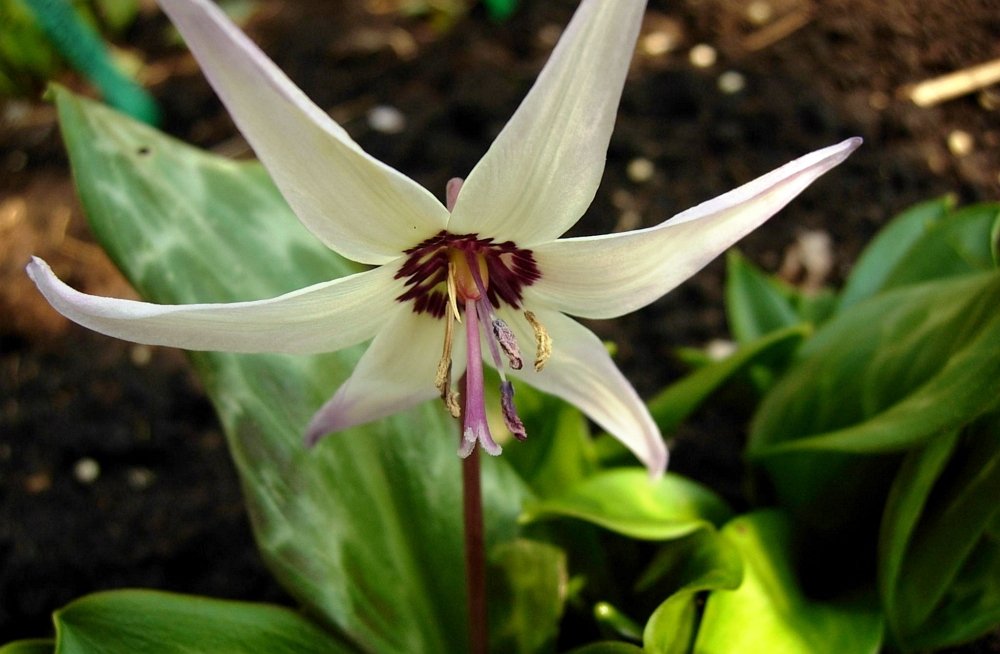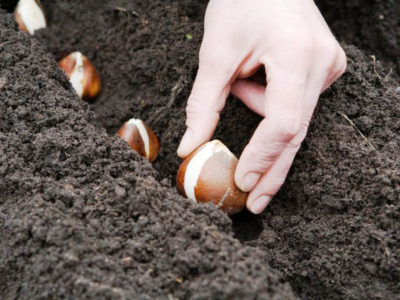
The earliest spring flowers. What blooms in April? The first flowers in your garden
With the first warm days, spring flowers bloom in the garden - and these are snowdrops, crocuses, and different kinds irises Not to mention that there are many magnificent primroses, unfairly forgotten, that can add special charm to the garden. How to grow the first spring flowers? What to look for when choosing a place for them and how to care for a flower garden?
Essence of the question
Which flowers appear first? Of course, these are snowdrops. These are unpretentious spring flowers that emerge as soon as the snow has melted. Snowdrops reproduce mainly by daughter bulbs or seeds, but the second option is used less frequently. The fact is that if these flowers are sown in open ground, then within 2 years they will germinate, but there will be no flowers on them. These white flowers do not appear earlier than the third year.
Snowdrops aren't the only early flowers. Crocuses look very beautiful in flower beds. Even if you plant seeds of the same variety, they can still differ greatly in color intensity. Such flowers in the garden are propagated by planting corms, that is, in the same way as other plants of this species (interestingly, this also includes the type of crocus from which the most expensive spice in the world, saffron, is obtained).
What flowers, besides those listed, belong to the category of small-bulbous primroses? This is, for example, muscari with their small but numerous inflorescences of blue and light blue (there are both pink and white specimens). Muscari has many names, including such unpresentable ones as, but it looks quite good, especially in border plantings.
A true classic of the genre is hyacinths, beautiful flowers with a very strong, although pleasant, odor. Hyacinths reproduce by small bulbs, which are located on the mother bulb in the summer. Such bulbs are planted in open ground earlier than older and more mature ones, that is, at the end of summer, so that they have enough time to take root. But they will grow to the point where the plants grown from them can bloom only after two years.
Small-bulbous plants that bloom in spring are a fairly large group. These include Pushkinia and Chionodoxa. The latter is often popularly called a snowman. It blooms very early, literally immediately after the snow melts. Chionodoxa has beautiful flowers of blue, pinkish or of blue color. This plant is easy to care for; the only requirement is annual replanting. But since Chionodoxa survives planting well, even during the flowering period, there should not be any special problems. This flower will look beautiful in a rock garden or on an alpine hill, it can enliven the lawn, and sometimes it is grown indoors.
As for Pushkinia, it is very unusual flower. At the same time, it belongs to the small-bulbous family, but it is very similar to them. The plant blooms with very beautiful white flowers, often in the middle of the petal there is a clearly visible blue stripe, which gives it an expressive appearance. Pushkinia reproduces using bulbs. Theoretically, you can use seeds, but this method of planting will take too much time for the plant to germinate. Bulbs are planted in the ground in the fall; in warm climates, this is best done in mid-October.
How to care for small bulbous plants?
All primroses love sun and loose, light soil. They need bright sun only when they are growing intensively, and later they need shade. Therefore, it is best to plant small-bulbous plants in the shade of deciduous trees. In early spring there is not much shade there, but by the time they bloom, there will be enough foliage on the trees to protect them from the sun. In the same area of the garden, primroses can grow well without replanting for about 6 years, but only if proper care. In addition, in order for them to be durable enough, they need to be protected from stagnant water. That is why such flowers are often grown in rock gardens or rock gardens, because there is a natural drainage layer
These spring flowers, whose names are familiar to everyone from childhood, look great in the garden. With their appearance, it becomes colorful and sunny. But most of them bloom for only a short time; their fruits and seeds ripen in a maximum of 3 weeks. After this, the aboveground part of such plants begins to gradually die off. Other flowers are already coming to the fore. But the bulbs of these plants can be planted in the ground again next year, and they will again fill the garden with spring colors.

To improve the quality of the bulbs, you should never pick off the leaves if they are not yet completely dry. In such flowers, nutrients accumulate in the leaves, and only then pass from there to the bulbs. By rushing, the gardener will deprive the plant of nutrients, it will be weakened, and the next year it may not bloom.
April flowers
Perhaps the most beautiful flowers of April are iridodictums. In everyday life they are often called irises; they are indeed very similar, but real irises are not a bulbous plant. They have green, less often bluish leaves, which can reach a length of 50-60 cm. They grow intensively, at the same time both a flower and leaves. In summer, their aboveground part dies off. But in April, for at least three weeks, this variety of irises will delight the garden owner with bright flowers of violet, blue, purple, light blue and even yellow. Iridodictum flowers are not too large, they can reach 5-7 cm in diameter. Their petals are covered with a thin pattern of stripes. In some varieties, the flowers even emit a subtle aroma.
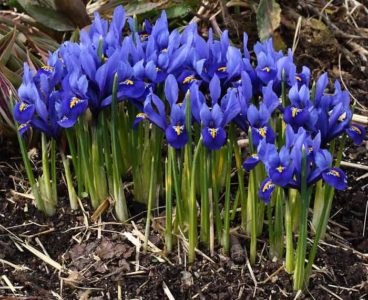
In order for iridodictums to bloom well, well-lit areas are chosen for them, and light shading is possible. Wet places are not suitable for these flowers. The soil should be light, loose, nutritious, and preferably with a neutral reaction. After flowering, these plants require warmth and dryness. In order for these bright flowers to appear from the ground in the spring, you need to plant the plants in open ground in September - then they will have time to take root before frost.
In April (sometimes in May, it all depends on the variety and weather conditions) daffodils bloom. Almost all varieties of these flowers will bloom for at least 20 days. And the choice of varieties is simply amazing - there are more than 30 thousand of them in the world.
In order for these spring flowers to look especially elegant, you need to choose the right environment for them. Low-growing varieties look best on alpine hills, where they will be surrounded by low plants. Taller daffodils can grow in garden beds and along roads. Small groups of daffodils look beautiful against the backdrop of a lawn or carpet. If there is an artificial pond on the site, then these shade-loving plants that tolerate moisture well will look very picturesque there.
Daffodils are not the first flowers to appear in the garden. Therefore, choosing a suitable environment for them is not difficult at all. At the same time, scillas, hyacinths and muscari (called “lamblets” in some regions) also bloom. The flowering period of daffodils practically coincides with tulips, forget-me-nots and primroses.
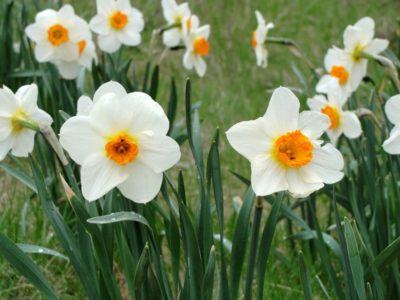
But daffodils will not bloom all summer, and their foliage may already turn yellow by June. Therefore, it is advisable to place them next to flowers such as peonies, daylilies, hostas and altibes. All these plants grow quickly in summer and hide the yellowed primroses.
Suitable species
Although lilies of the valley naturally live in the forest, mostly near bushes, there is also a place for them in the garden. The main thing is that they have enough moisture. Lilies of the valley have a well-developed root system. Because of this, he does not like his neighbors and actively drives them out of his territory. That is why it is better to plant it in the garden next to a bush - it simply cannot do anything with such strong roots.
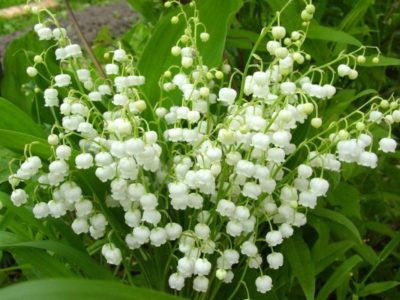
Some gardeners manage to grow lumbago, that same magical dream grass with very beautiful lavender flowers, on their property. In fact, the seeds of this plant are not at all easy to find. And in nature today it is on the verge of extinction. And if someone tries to dig up a plant listed in the Red Book, the consequences can be the most unpleasant.
But blueberries, although associated mainly with lawns and cozy forest corners, are actually more often found today in the garden than in the wild. It is beautiful and does not require special care. They reproduce by both bulbs and seeds. But the first option is still simpler, especially for a novice gardener.
Hellebores are gradually coming back into fashion today. Surprisingly, among primroses it is one of the few with evergreen leaves and fairly strong rhizomes. It blooms in April, and in more severe climatic conditions - in May. Hellebore is distinguished by very beautiful flowers, the petals of which have an original texture and can be either light, yellowish, slightly transparent, or intensely red. They are grown in partial shade.
Many gardeners love such a colorful and cheerful flower as hazel grouse. He has a really unusual color. , resembling umbrellas in shape, look very impressive precisely because of this spotting. To breed hazel grouse, it is important to choose the right soil; although it should be light and nutritious, for this flower it is better to add peat. Hazel grouse are planted in early autumn, but in general it is not too late to do this before mid-September.
Violets and liverworts look charming in the garden. The fragrant violet with its blue-blue flowers is often adjacent to daisies. Violet seeds must germinate in the dark; before that, they spend the entire winter in a dark and cool place. About a month after sowing, the seedlings can be plucked and then planted in a pot or open ground. The climate of the southern regions allows violets to be left for the winter, but this is still a risk, even if covered with spruce branches. The liverwort is similar to the violet both visually and in terms of cultivation techniques, but its color is closer to bright blue, without an admixture of purple, and its flowers are much smaller - there are so many of them that they cover the ground with a carpet.
Primrose is found quite often in the garden. Because of this, many consider it a somewhat banal and hackneyed choice. But firstly, there are many types of primrose, and some of them look very impressive. Secondly, primroses are unpretentious; they can bloom in the garden when other species do not want to take root at all. It is best to buy flowering specimens to ensure there is no mistake in color or variety.
As a conclusion
Although the choice garden plants often subject to capricious fashion, daisies are like a string of pearls, they always remain relevant. These plants can be either annual or perennial. However, the term “perennial” is a convention. They are rarely grown for more than 2 years, since the flowers begin to become smaller and their color becomes less bright. Most varieties of daisies bloom in May.
Today the lungwort is a little forgotten, and completely in vain, since it is very beautiful flower with pink or dark blue petals. The unpretentious lungwort can live in the garden for about 30 years.
And a little about secrets...
Have you ever experienced unbearable joint pain? And you know firsthand what it is:
- inability to move easily and comfortably;
- discomfort when going up and down stairs;
- unpleasant crunching, clicking not of your own accord;
- pain during or after exercise;
- inflammation in the joints and swelling;
- causeless and sometimes unbearable aching pain in the joints...
Now answer the question: are you satisfied with this? Can such pain be tolerated? How much money have you already wasted on ineffective treatment? That's right - it's time to end this! Do you agree? That is why we decided to publish an exclusive interview with Professor Dikul, in which he revealed the secrets of getting rid of joint pain, arthritis and arthrosis.
The smell of spring has just begun, and the first, still very timid and delicate flowers are gradually beginning to awaken in your garden. It is quite difficult to describe what happens in the soul of a gardener when snowdrops begin to appear among the islands of snow and the gloomy fallen leaves of last year, rotted over the long winter.
Very little time passes, and crocuses, quinodoxes, and scillas come to life on the site. And now the first rays of the sun begin to slowly warm the earth. April has come, and with it spring has come...
You are happy to observe the awakening of nature. Bulbous plants wake up first, then tuber-bulbous plants. Interestingly, every spring in Moscow an exhibition of primrose flowers is held in April. Many visitors don’t even realize that all these gentle beauties and handsome men are patient and unpretentious residents of our garden plots. And many leave the exhibition with the intention of paying more attention to primroses, since these delicate creatures seem to be asking for love and protection.
What blooms in April?
Certainly, Hellebore . In Russia, three species are most common, which differ in flowering time. Hellebore is quite decorative. The flower is large with five greenish, yellowish, pink or purple petals. Hellebore is considered a poisonous flower, and its rhizome is widely used in medicine.
A flower begins to form under the snow Erantis . Bright yellow, like a sunny flower, blooms for about two weeks. Moreover, Erantis is not afraid of either night frosts or daytime warming. Erantis are planted on light soils in open areas near deciduous trees. They bloom only in the third or fourth year. Sometimes the seeds can be carried away by ants, so don’t be surprised if yellow flowers appear far from where you expected them.
Just like Erantis, our beloved women and children begin to grow under the snow. Snowdrop . However, many early flowers are called snowdrops - woodland, anemone, and coppice. The classic snowdrop has only two petals, folded in the form of a drop. The plant can be, depending on the species, either tall or short. Snowdrops planted in islands look very impressive in the garden.
Blooms around the same time as the snowdrop Spring whiteflower . A delicate white flower resembling a lily of the valley with small specks on each petal. Fragrant and very decorative. Widely used to decorate rock gardens and rockeries. The white flower is also depicted on the coat of arms of the city of Ettenstat (Germany), since it blooms beautifully in the forests nearby and is, one might say, a city landmark.
Very beautiful spring Crocuses (or also called Saffron). White, yellow, blue, purple flowers Crocuses are an excellent option for spring landscape design, especially in open sunny areas. Crocuses are also widely used as a spice and as a food coloring. But their decorative properties and unpretentiousness are much more in demand. Crocuses do not stop their vigorous flowering even if the frost reaches 7 degrees.
Pereleska or else called liverwort due to the similarity of the leaf shape to a human organ. A forest evergreen plant that has been used for centuries folk medicine. Under favorable conditions, the liverwort can safely be called a long-liver. It can grow and delight you with its first spring flowering for up to 25 years. The most famous are the pink and blue terry (due to the delicate cilia - stamens) forms. By the way, Japan hosts entire exhibitions of flowering liverworts. Today there are a lot of new species of these plants, but selection continues, and it should be noted that each new variety bred attracts the close attention of gardeners. The prices for these new items are also steep. They can reach 1.5-3 thousand dollars.
Scillas or else called Scylla , can decorate the garden with bright multi-colored colors. They are frost-resistant, unpretentious, and thrive in damp, shaded areas. Scillas are periodically confused with liverwort and snowdrop. It is very beautiful to plant borders and mixborders from woodlands in landscape design. Scylla also look quite harmonious among stones, so if you have the opportunity to combine stone embankments with moist, fertile soil, then scillas are just for you!
Chionodoxa It may bloom at the same time as the scilla, or maybe a little earlier. Its blue star-shaped flowers will delight you both in an open area and in partial shade if you offer fertile, humus-rich soil.
To the early spring flowers include and Kandyk , or also called Erythronium europaea or Dog tooth . The last name is due to the fact that the shape of the kandyk bulb resembles a dog’s fang. Kandyk, in addition to its decorative properties, widely used in rock gardens, is an excellent honey plant. And kandyk honey has unique healing properties.
Blooms a little later Muscari or Mouse hyacinth - bluish-violet flowers on the arrow up to 15 cm high. In the garden, muscari harmonizes perfectly with most plants and with stones. You can use them to make borders, mixborders, or decorate a rock garden or rock garden.
In mid-April they begin to bloom and early Daffodils . First, the white beauty of the Icepholis variety appears, then other fragrant, terry, tubular, single-color or two-color varieties appear. Daffodils are capable of giving simply amazing atmosphere in flower beds. Fertile soil in a windless, sunny or slightly shaded area is suitable for growing them.
Don't worry that when spring begins your area will be an unattractive dark spot. Plant beautiful perennial early ornamental flowers. Let them give you joy with their delicate petals, just peeking out from the melted snow.
The time has come when the garden comes to life: crocuses, muscari, erantis, snowdrops, daffodils and other April flowers bloom. April has arrived, and with it - real spring!
This time I want to tell you, dear readers, about the flowers that open my summer season every year. Perhaps some of these plants will interest you too. In this case, do not forget to plant them in your flowerbed so that next spring this floral luxury will delight you too.
What an April flower garden cannot do without is crocuses. These bulbs are very popular with gardeners, and I like them too. White, yellow, blue, purple... Crocuses will fit into the landscape of any garden, the main thing is to choose the variety that you need. I plant different ones - and the more colors, the brighter the spring!
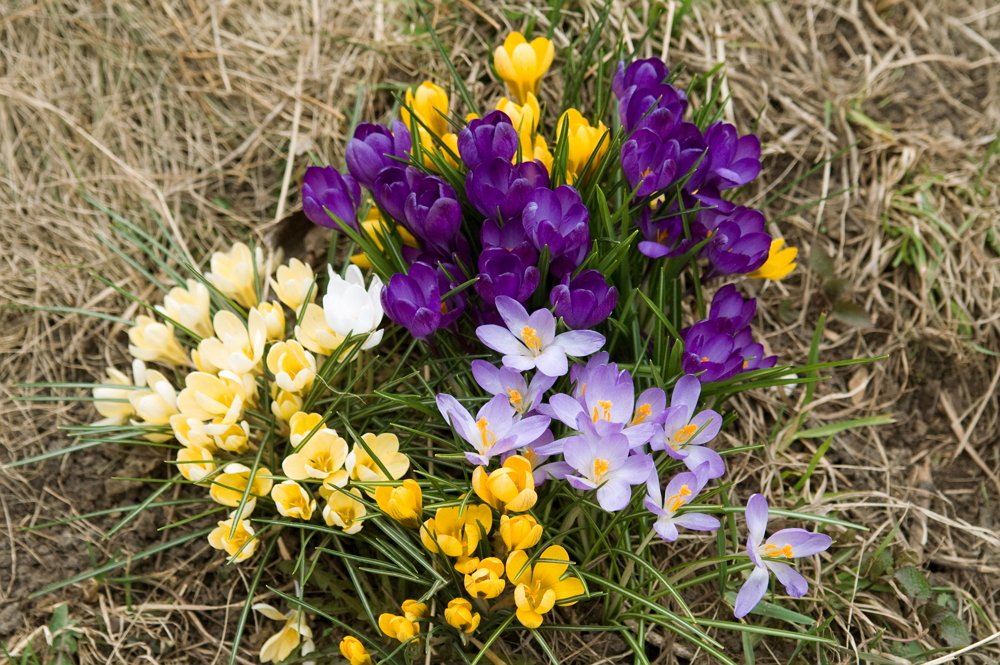
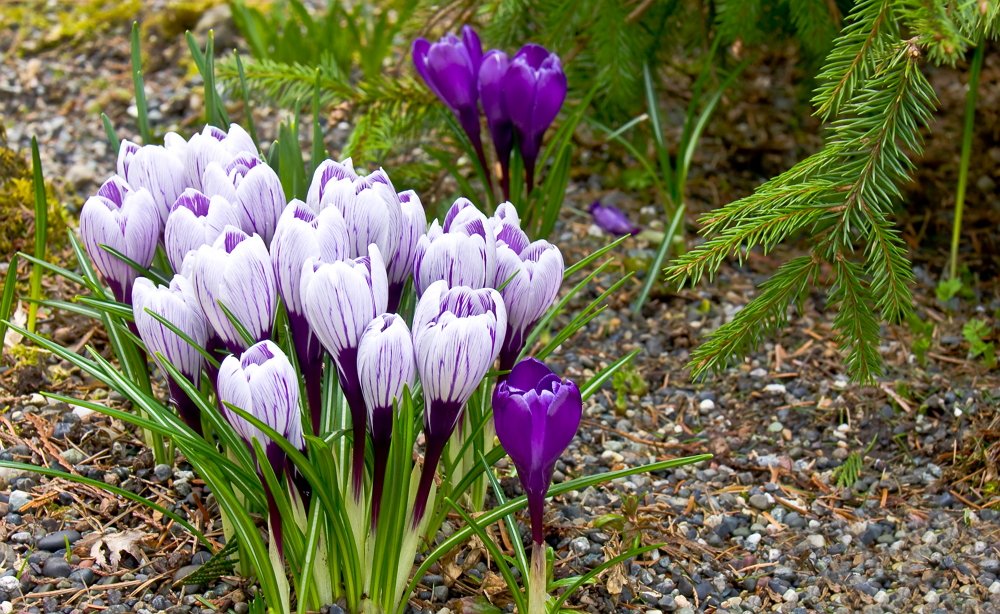
![]()
Another charming inhabitant of my flower garden - hellebore. Just look how delicate and exquisite its buds are. Hellebore flowers are large, and the petals are yellow, pink or purple. Pure white hellebores are no less good.
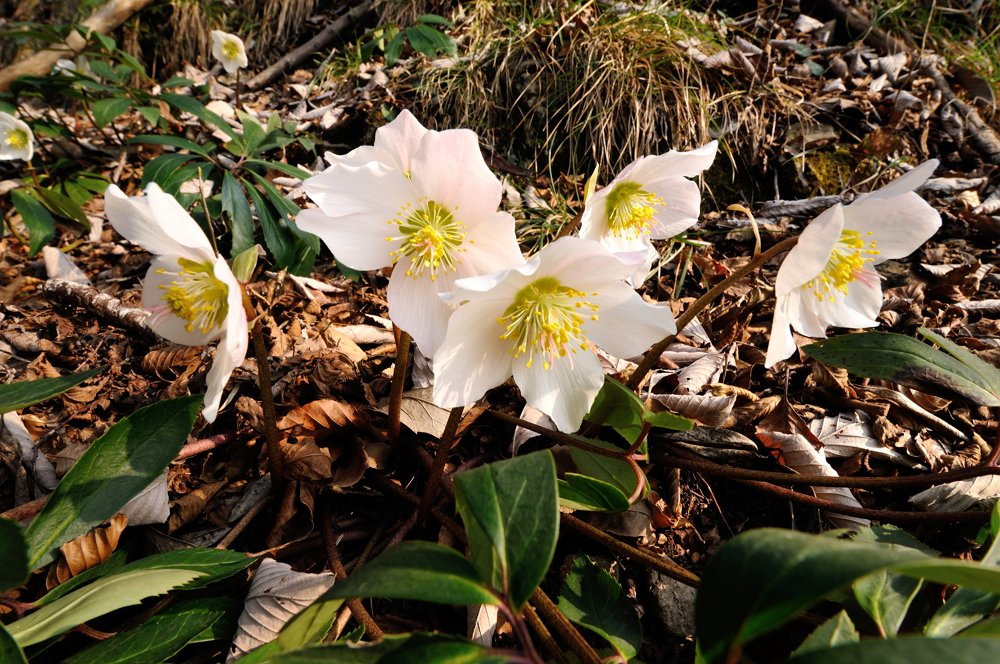
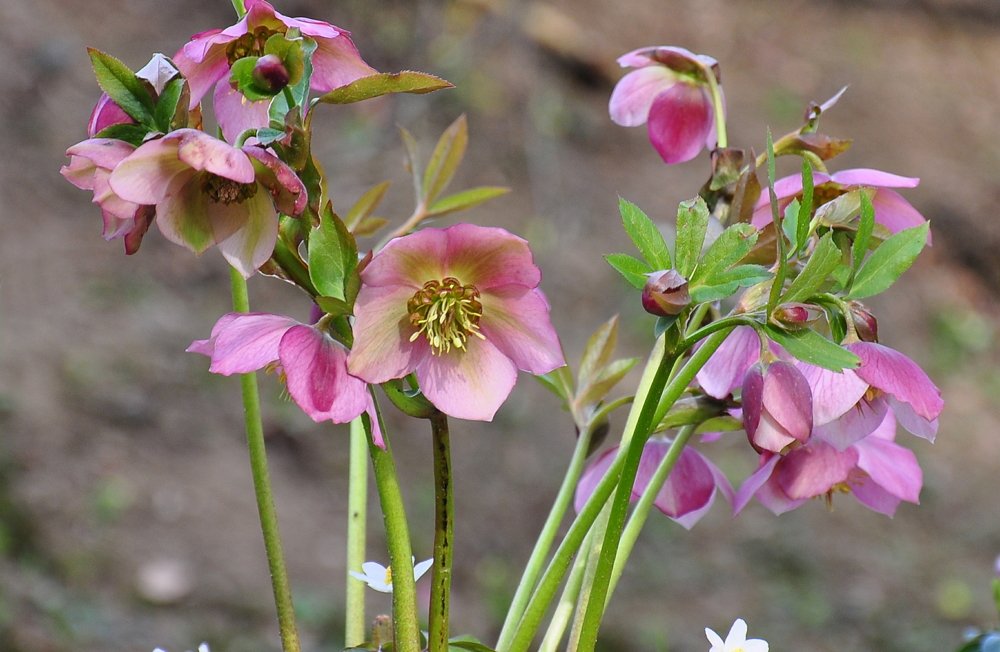
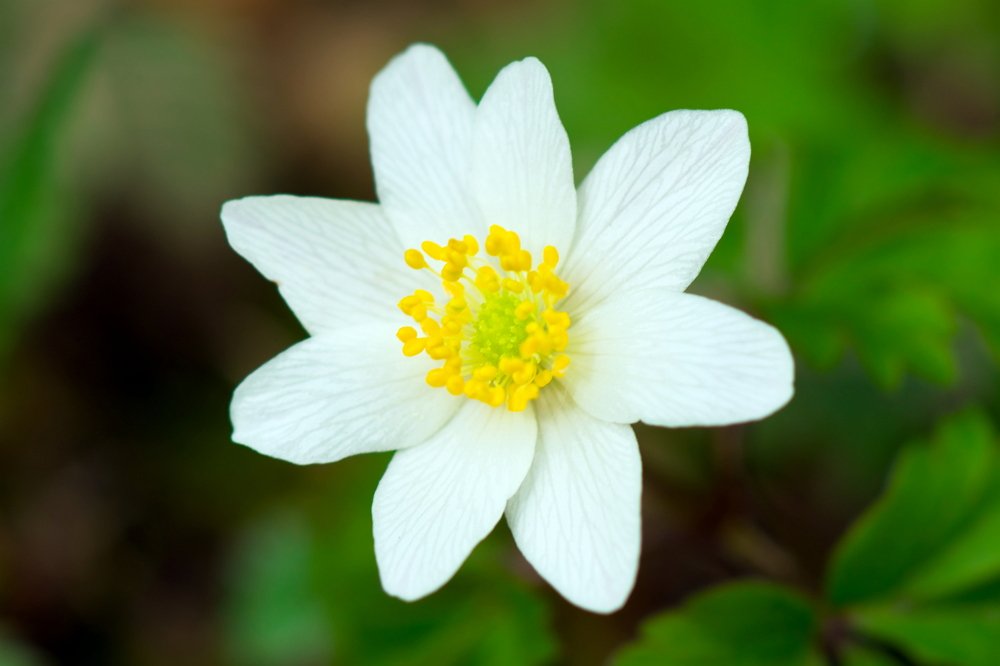
It’s impossible not to say about solar Erantis. Bright yellow flowers with a green carved “skirt” they are not afraid of sudden changes in temperature and can withstand cold April nights well. Personally, erantis remind me of miniature hula dancers - such “Hawaii” in the flower garden of the middle zone.
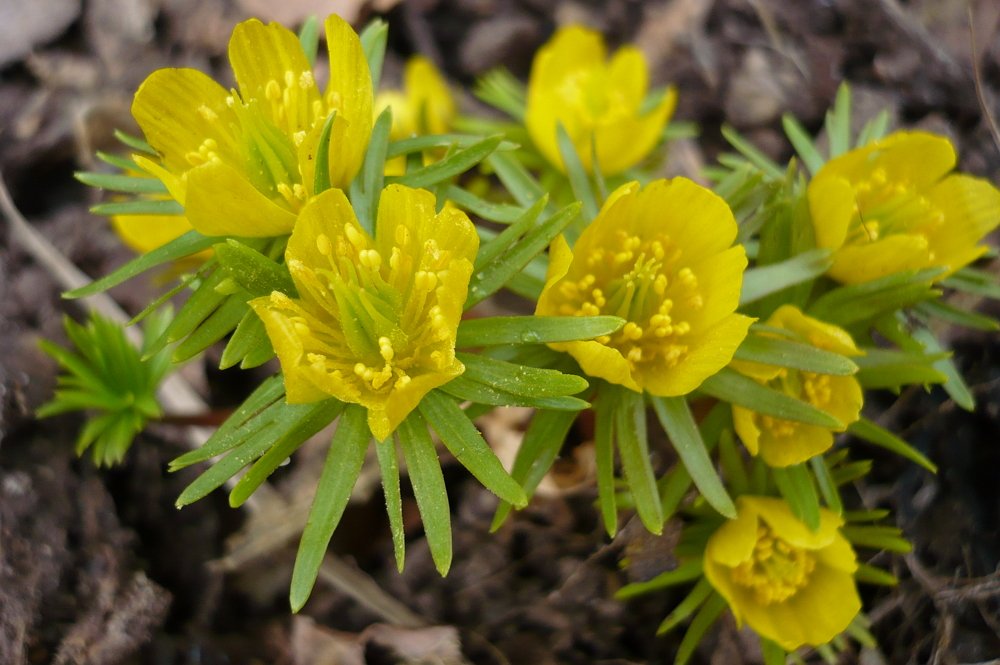

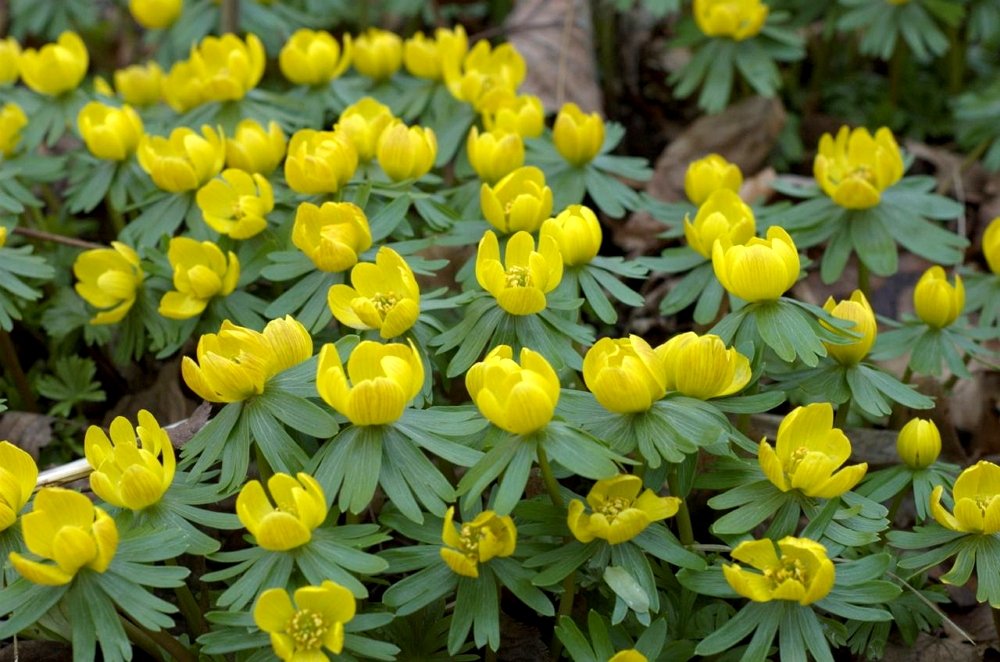
Along with the Erantis, they rush to appear from the barely thawed ground snowdrops. These flowers should not be confused with blueberries or anemone - these are different plants. I plant snowdrops in “islands” - this is how they look most advantageous.
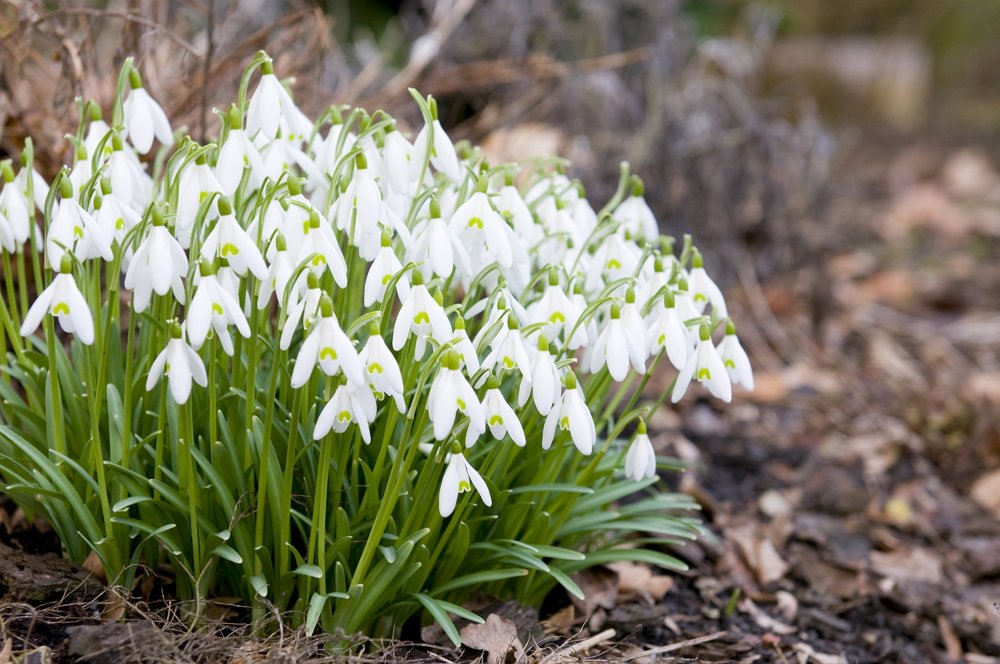
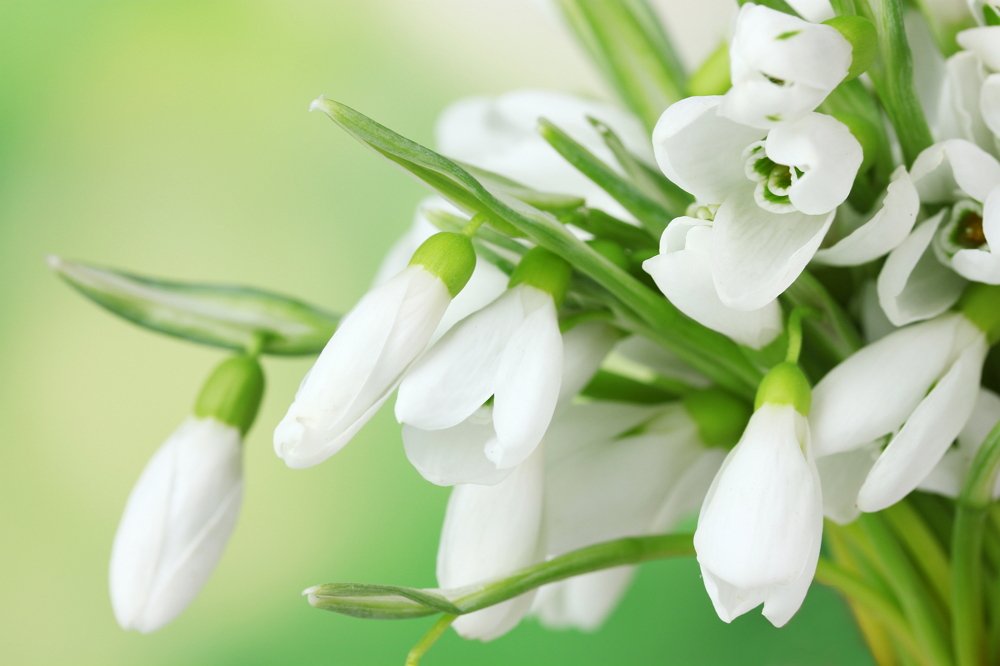
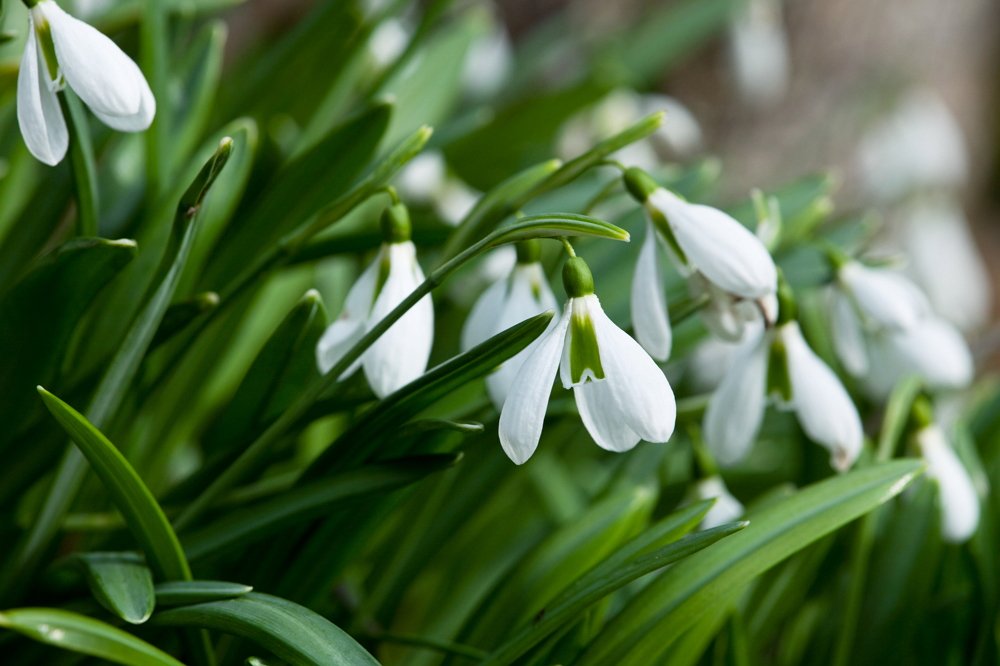
Instead of snowdrops you can plant spring whiteflower. This plant resembles a lily of the valley, only with yellow-green specks at the ends of the petals. Unusual whiteflower bells decorate my alpine hill every spring.
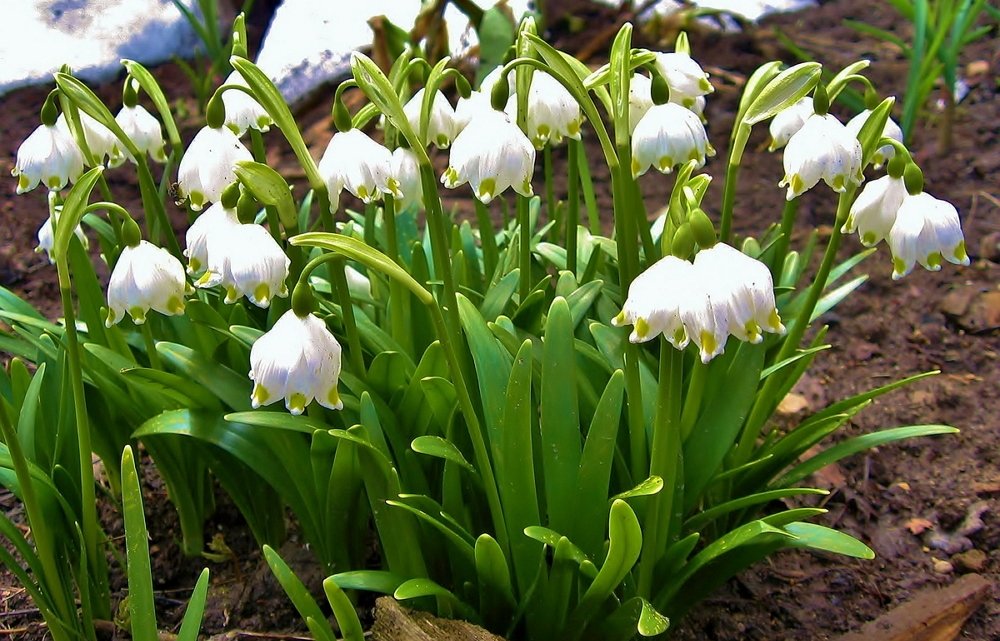
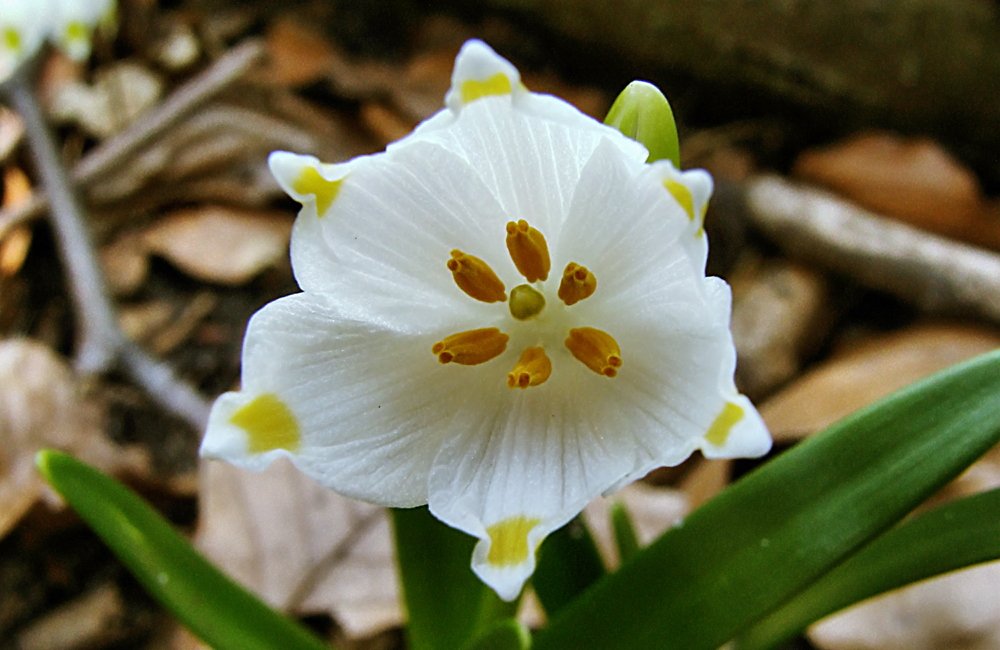
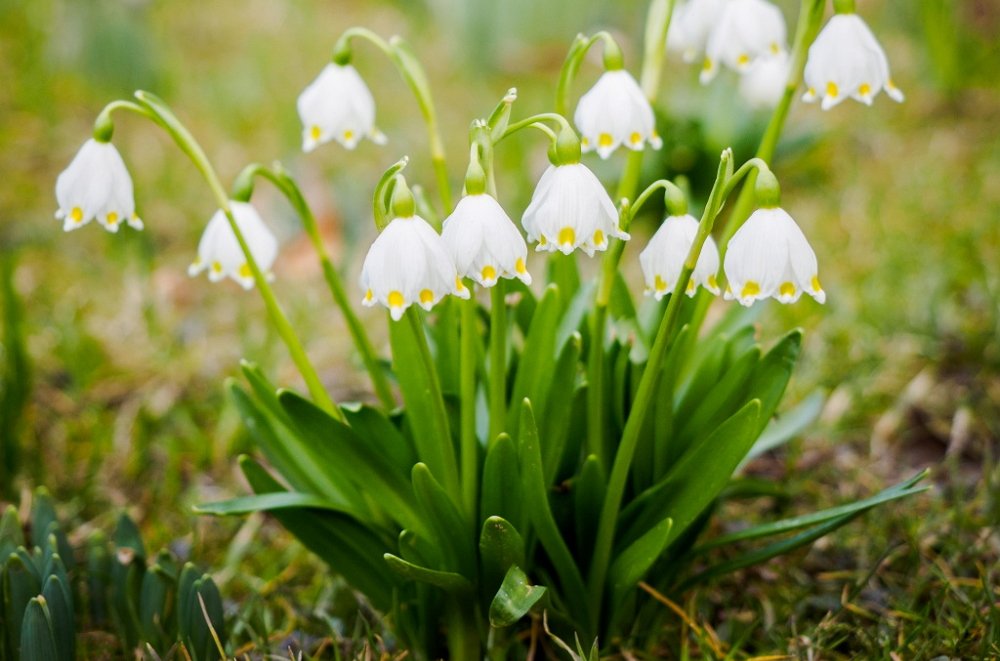
Scillas which are also called scylla, I’ve been “sitting” in curbs and mixborders for many years now. These are another flowers that are given spring garden bright colors. In addition, blueberries are good because they are frost-resistant and unpretentious. Just do not confuse scylla with liverwort or snowdrop.
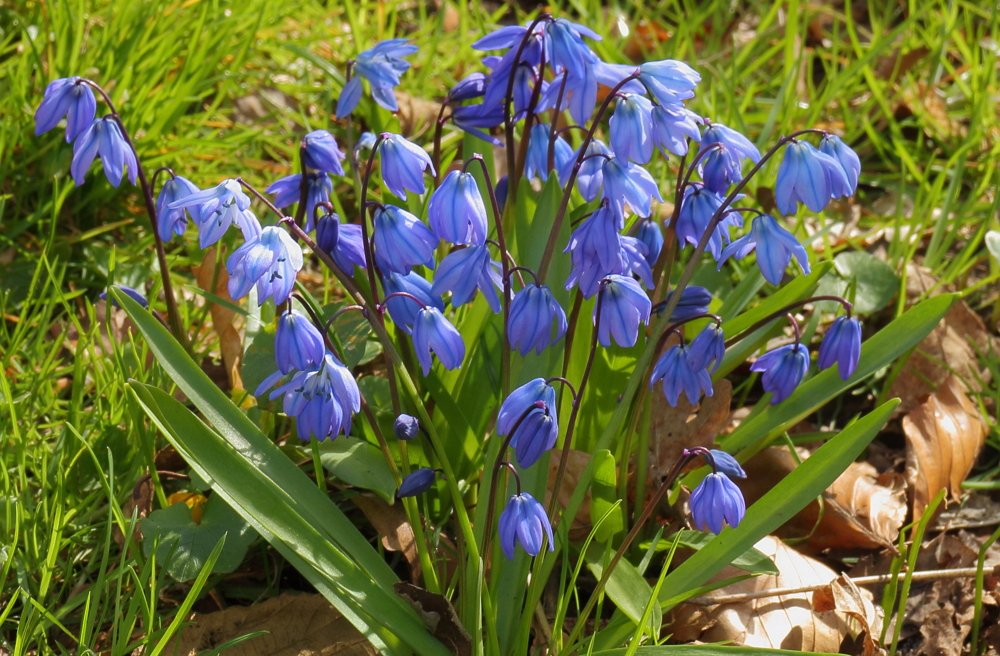
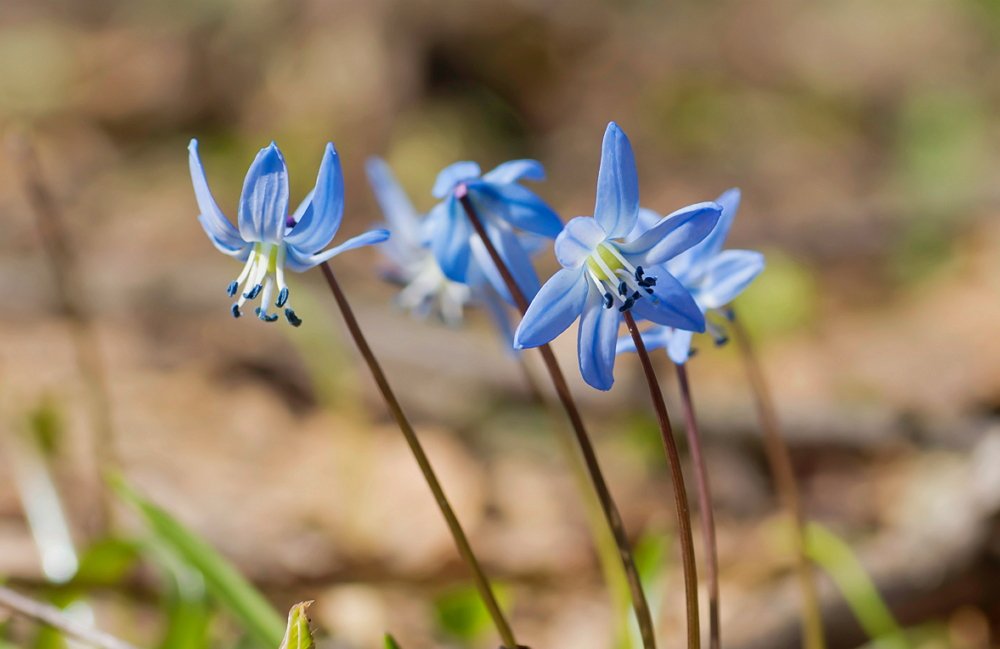
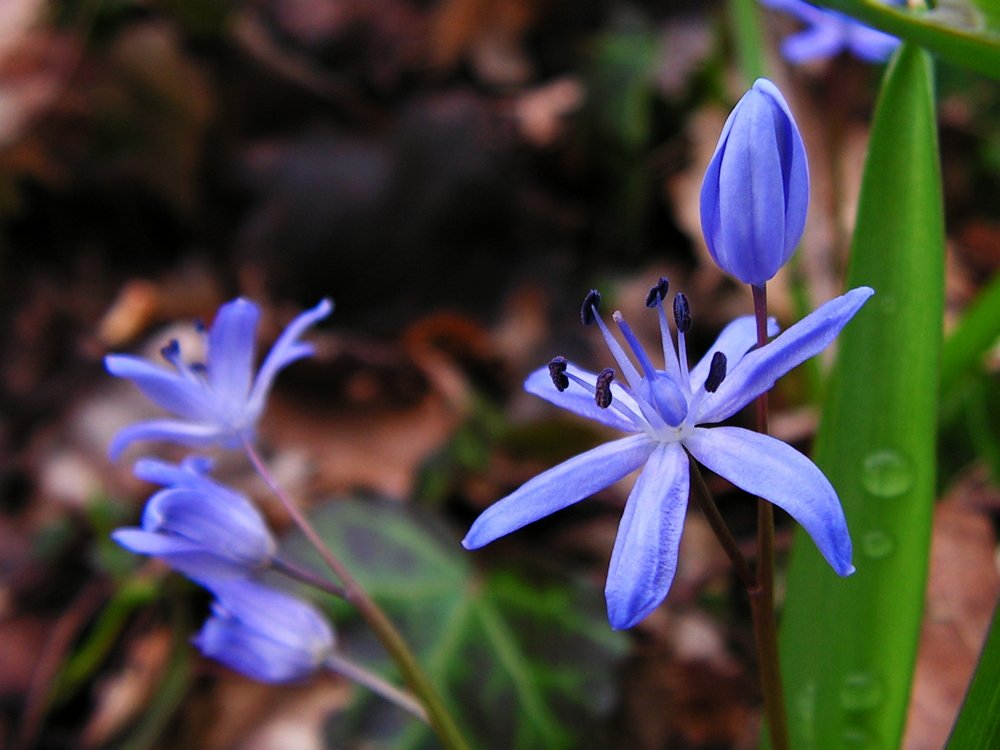
It takes a worthy place in my flower garden kandyk, which is popularly nicknamed dog tooth. They say that the plant received such an unusual name because its bulbs resemble fangs. So be it, but in my opinion, this name is not at all suitable for such a delicate and fragile flower. I also recommend planting Kandyk in a rock garden - that’s where it looks most advantageous.
